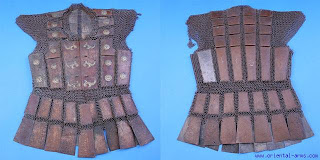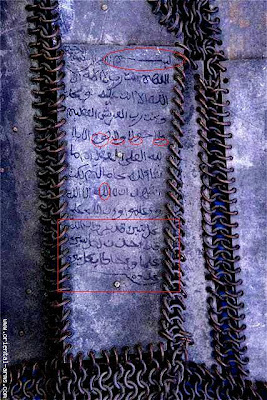
One of the Moro armors that has really convinced me that the Ottoman Turks did reach the Philippines, particularly Sulu, is the armor above made of copper or brass plates (I am not sure what kind of metal chips they are). It almost looks like the buffalo horn armors-- in chip, button, chain, and okir designs. This armor, to me, is Turkish.
What has convinced me is the Arabic inscription, a Quranic passage, on the back of one of the chips. Unlike the Ottoman Turks, Mindanaoan Moros had no tradition of writing Islamic verses in Arabic on armors and weapons. The Moros did not speak or write in Arabic. They had their own malay-based dialects, and they too used Baybayin, the early Philippine writing system, before the Spanish came.
There are historical papers that show Moros wrote in baybayin, but I don't think there are evidence showing that the Moros used Arabic as a medium of communication before the Spanish colonization. Most Moros could not even write in sixteenth century. According to William Henry Scott, some datus could not even sign their names on affidavits, oaths, and land deeds. If the datus couldn't write, why could the warriors?

Arabic was not even used by the Moros when they first wrote Darangen, a Moro epic. It is just unthinkable that they would use it on armors. Nowadays, only few can speak and write Arabic in the Philippines. Its teaching began when the madrassa system of education was implemented by the Muslim priests and scholars in Mindanao. It is a twentieth-century literacy development among the Muslims in the Philippines.
I don't speak Arabic, but I have Arab friends who told me that these Arabic scripts are old. Most of them were not even familiar of the scripts on the metal Armor. They all said though that the writings were related to Quranic teachings since using Arabic in relation to objects used in war is an act of faith. Early Muslim warriors used the surah verses as amulets or protective prayers.

I am using the plural "scripts" because two kinds of Arabic writings were used. The first one is thuluth, and the one in the box is nastaliq. Both Arabic scripts were developed and used by the Ottomans. Thuluth is recognizable because of its downward slopes, while nastaliq uses many dots. A tentative translation of the passage supports my two-scripts theory.
The one written in thuluth uses the second person singular pronoun "you" while the one in nastaliq has the third person singular "he" as its masculine pronoun. There is a possibility that the the nastaliq passage was added later. The use of two scripts also suggests that the Turks indeed stayed for awhile in Malay archipelago, Sulu included. We can see the use of two scripts in transition.
A third of every word in thuluth script is a downward slope. Thuluth means "third" in Arabic. It is clear that tulo and tatlo, meaning "three", in Philippine major languages came from the Ottoman's thuluth. Malay has tiga, Sanskrit, trayas, tisra, and tri, and Tamil, moondru. It is intriguing why Cebuanos have tulo and Tagalogs, tatlo. As I see it, it is also a linguistic evidence that the Ottomans did reach Mindanao bringing the thuluth script and driving their enemies.
Nastaliq or taliq is known for its clear and fluid writing. Taliq, which means separate, probably got its name from the qalam, a pen made out of reed, which has a nib split in the middle or from the clear, distinct separation, space-wise, in writing. Some Muslims say taliq to divorce from their spouse. Interestingly, in the Philippines, talik means union, closeness, and sex. I wonder if there is a connection between the two words.
There are a lot of Turkish words in Philippine languages. Most of them are obviously related to violence, raid, and war. Bisaya Dusmag (stab) is from dusmek (fall). Tagalog alab is from alev, and they both mean flame. Siga means physically powerful in Tagalog and Turkish. Iyo in Tagalog means yours while iye in Turkish means owner. Sabit for both means fixed or attached.
There is even a word related to tribute or taxation. Kain in the Philippines means food or eat while in Turkey, it means poultry or stuff paid in kind by a tenant to his landlord. Turkish arak became alak in Tagalog. They are drinks. I am still trying to compile Turkish-loaned words in Philippine languages. So far, the ones I have gathered are mostly not nice words.
The Turkish words that entered the languages of the Filipinos are very telling of the violent activities and nature of the Ottomans. I have a feeling that they were not nice people when they were in the Islands. They must have raided, killed, and drove away the Hindus. Thus, only faint traces of Hinduism and Indic culture have survived in the Philippines. Yes, I believe it was the Ottoman Turks who caused the violent decline and demise of the Majapahit empire.



|